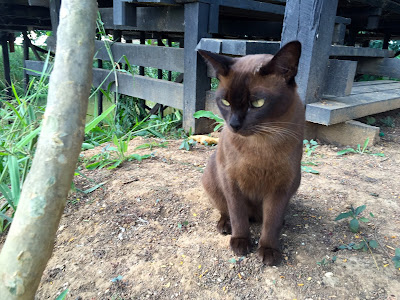My Trip to Burma: A visit to the Inthar Heritage House and their Burmese Cat Sanctuary!
It’s not difficult to find Russian blues in Russia, Scottish
folds in Scotland, or Turkish vans in Turkey.
But try finding a Burmese cat in
Burma. It’s not as easy as you think.
During
the 19th and 20th century, increased development led to a
large influx of people (and cats) into Burma, resulting in the rise of other
cat breeds. The Burmese breed was
gradually diluted, becoming hybrids. A few purebreds were brought to the U.K.,
and one was brought to the U.S. By 1930,
true purebred Burmese were gone from Burma.
Now this popular and well-loved breed, with their beautiful color, big
eyes, and gentle temperament are adored in North America, Europe and Australia,
are virtually unknown to the Burmese people. The Inthar Heritage House’s
Burmese Cat Conservation Project hopes to change that.
I met Chaw Su, the petite, charming woman who manages the
program. She filled me in on the
history. Mr. Wong How Man of the China
Exploration and Research Society (CERS) thought it was a travesty that no
Burmese cats could be found in his home country, so he brought some purebred
Burmese back to Burma in August of 2008.
The cats were selected carefully, and only seven made the grade.
Initially, they were housed at the Inle Princess Resort, where proprietor and
conservationist Yin Myo Su contributed 2 bamboo huts to be used as a breeding
facility. After a year, the number of
cats grew rapidly and a larger space was needed.
 I
entered the sanctuary area and was greeted by a mob of adorable, friendly
felines. Strewn with comfortable beds, a
variety of perches, and endless toys, the facility is a feline
fantasyland.
I
entered the sanctuary area and was greeted by a mob of adorable, friendly
felines. Strewn with comfortable beds, a
variety of perches, and endless toys, the facility is a feline
fantasyland. Projecting from the main cat room is a bridge that that leads to a private island containing several small playhouses – replicas of King Thibaw’s Mandalay palace – for the cats to lounge in. A moat around the island prevents the cats from straying.
As a
veterinarian, my medical radar was primed, but except for an occasional runny
nose, all of the cats looked fit and healthy.
I asked Chaw Su about the breeding program. “We have 40 cats here, 23
females and 17 males. The breeding stock
consists of seven queens and three toms.”
Most of my patients in the U.S. are the classic chestnut brown. Here, however, variety rules.
“Most of our cats are brown”, said Chaw Su, “but we
have blue, lilac, and champagne, too.” That's a champagne one above on the left, and the classic chestnut one on the right. That's a lilac below.
 On the island, there are little houses where the cats can chill out. I made quick friends with the cat who lived in this one. Look how well socialized these cats are. This beautiful chestnut brown boy was loving the attention, letting me rub his belly while he stretched out to make sure I hit every spot.
On the island, there are little houses where the cats can chill out. I made quick friends with the cat who lived in this one. Look how well socialized these cats are. This beautiful chestnut brown boy was loving the attention, letting me rub his belly while he stretched out to make sure I hit every spot.
It's so nice to see how they have the entire little island to themselves.
This girl, on the island, was super friendly and climbed up on my shoulder.
This girl, on the island, was super friendly and climbed up on my shoulder.
Besides the Burmese cat sanctuary, the Inthar Heritage House also has a restaurant, and we ate lunch there. We got a table on a terrace with a pretty wonderful view.
This is a very upscale restaurant, and it was our most expensive meal of our trip. It was a prix fixe menu. This tray of amazing starters, a main dish (pork curry), and dessert (banana cake for Mark, chocolate cake for me). Cost for each of us: a whopping $25,000 kyat (about $22).
The
Inthar Heritage House aims to preserve the cultural and natural heritage of the
Inle Region. Burmese cats are part of
this national heritage, and their Burmese Cat conservation program is well on
their way to achieving their goal of repatriation of the Burmese cat to
Burma. 





























Comments
Post a Comment